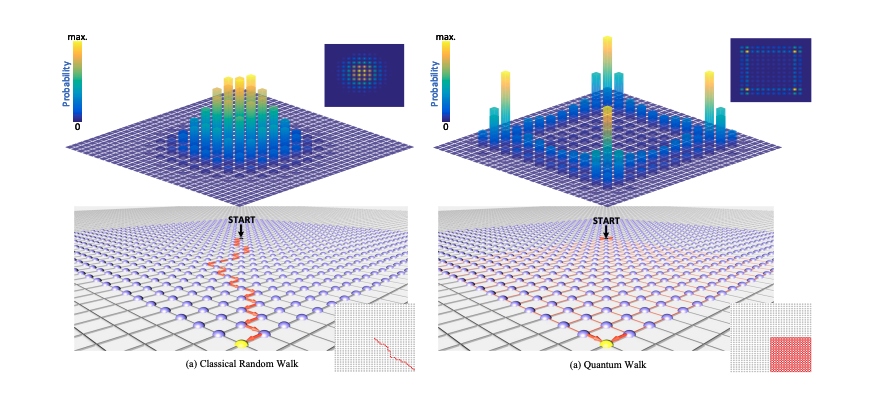Quantum walk computing, a theoretical model for quantum computing, leverages quantum effects like superposition, interference, and entanglement to surpass classical computing power. It has been used in designing quantum algorithms for various fields, including algebraic problems, optimization, graph and network analysis, and quantum Hamiltonian and biochemical process simulations. Quantum walks are particularly promising for application-specific quantum computing in the current noisy intermediate-scale quantum (NISQ) era. Despite significant progress in implementing quantum walks, challenges remain in realizing a practical quantum computer using this model. However, the future of quantum walk computing looks promising as it is expected to play a significant role in the development of practical quantum computers.
What is Quantum Walk Computing and Why is it Important?
Quantum walk computing is a theoretical model for quantum computing that exploits quantum effects such as superposition, interference, and entanglement. Quantum walks have been extensively studied for their potential to achieve beyond classical computing power. They have been used in designing quantum algorithms in fields ranging from algebraic and optimization problems, graph and network analysis, to quantum Hamiltonian and biochemical process simulations. Quantum walk models have proven their capabilities for universal quantum computation.
Compared to conventional quantum circuit models, quantum walks show a feasible path for implementing application-specific quantum computing, particularly in the noisy intermediate-scale quantum (NISQ) era. The NISQ era refers to the current stage of quantum computing development, where quantum computers are not yet fault-tolerant but can still be used for practical applications. Quantum walks are seen as a promising path for implementing quantum computing during this era.
Recently, significant progress has been made in implementing a wide variety of quantum walks and quantum walk applications. This demonstrates the great potential of quantum walks. However, challenges remain in realizing a practical quantum computer using quantum walk computing.
How Does Quantum Walk Computing Compare to Classical Computing?
Quantum computing is a computing model based on quantum mechanics. It utilizes quantum physics effects such as superposition, interference, and entanglement to achieve computational power beyond classical computing. With the potential of quantum computing, tasks that may be intractable to classical computers could be solved with exponential or polynomial speedup by quantum algorithms. These tasks range from factoring a large prime number and searching an unsorted database, to simulating quantum systems and solving large systems of linear equations.
Quantum walks are the quantum mechanical equivalent of classical random walks. A classical random walk is used to describe a particle, named a walker, that moves stochastically around a discrete space. In a quantum walk, the walker is governed by quantum physics effects and shows markedly distinct properties compared to a classical random walk. Quantum walks have shown beyond classical potentials in a variety of problems in the fields of quantum computing, quantum simulation, quantum information processing, and graph theoretic applications.
What are the Applications of Quantum Walk Computing?
Quantum walks have been broadly used in designing quantum algorithms in fields ranging from algebraic and optimization problems, graph and network analysis, to quantum Hamiltonian and biochemical process simulations. Quantum walk models have proven their capabilities for universal quantum computation. They have been used for tasks such as database search, distinguishing graph isomorphism, network analysis and navigation, and simulating quantum Hamiltonian dynamics.
Quantum walk models also play a key role in demonstrating quantum supremacy over classical computers. A boson sampling task, for example, can be viewed as particular instances of multiparticle quantum walk on specific graphs. Even for a single-particle quantum walk case, it has been shown that sampling quantum walks evolution probability on an exponentially large circulant graph is classically intractable.
What are the Challenges Facing Quantum Walk Computing?
Despite the significant potential of quantum walks, challenges remain in realizing a practical quantum computer using quantum walk computing. One of the main challenges is the physical implementation of quantum walks. A variety of quantum physical systems are used for physically implementing quantum walks and their applications, such as superconducting trapped ions and atoms, bulk optics, and integrated photonics systems. These physical implementation approaches are rapidly developing, showing great progress in both the scalability and programmability of quantum walks. However, further advancements are needed to fully realize the potential of quantum walk computing.
What is the Future of Quantum Walk Computing?
The future of quantum walk computing looks promising, with remarkable progress having been achieved in implementing a wide variety of quantum walks and quantum walk applications. However, the field is still in its early stages, and much work remains to be done. The development of quantum computing has passed through the stage of a prototype of demonstrating basic quantum operations and small quantum algorithms, and quantum computational advantages have also been experimentally demonstrated on certain tasks. However, the universal fault-tolerant quantum computer remains still underway. As the field continues to advance, quantum walk computing is expected to play a significant role in the development of practical quantum computers.
Publication details: “Review on Quantum Walk Computing: Theory, Implementation, and
Application”
Publication Date: 2024-04-05
Authors: Xiaogang Qiang, Shenglin Ma and Hucheng Song
Source: arXiv (Cornell University)
DOI: https://doi.org/10.48550/arxiv.2404.04178

